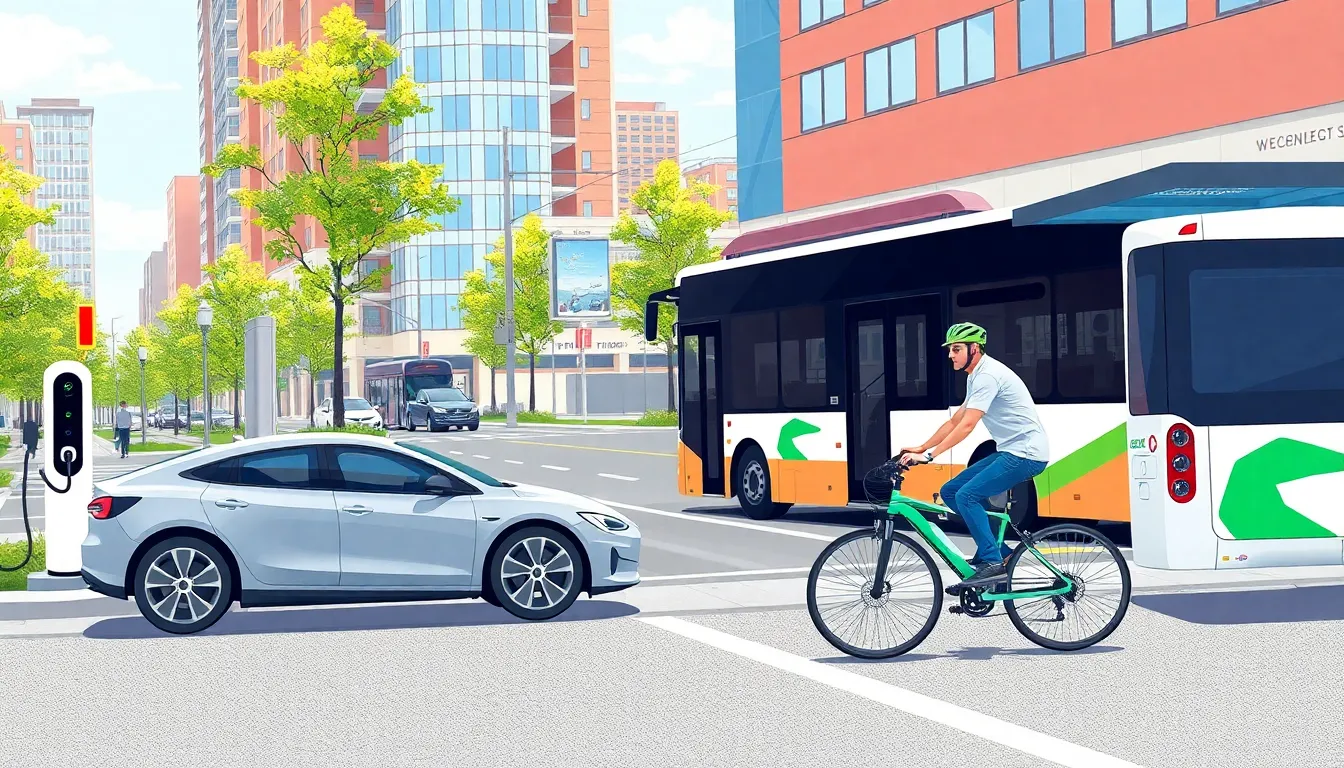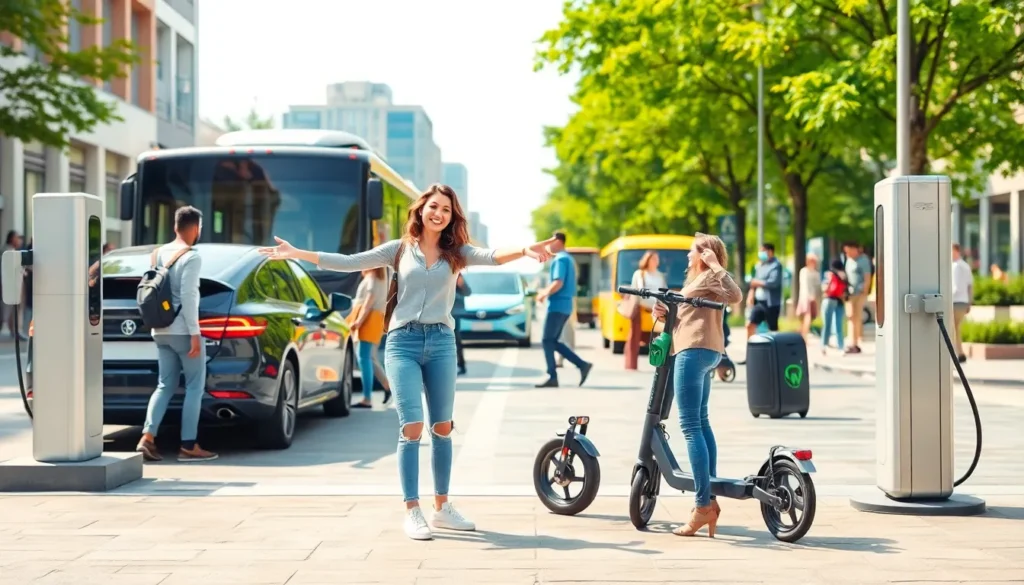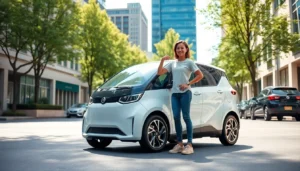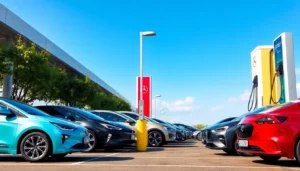In a world where traffic jams feel like a never-ending game of musical chairs, electric transportation vehicles are here to save the day—and the planet. Imagine gliding silently past gas-guzzlers, all while reducing your carbon footprint and saving some serious cash on fuel. It’s like having your cake and eating it too, but with fewer calories and more eco-friendly vibes.
Overview of Electric Transportation Vehicles
Electric transportation vehicles encompass a wide range of options, including electric cars, buses, scooters, and bikes. These vehicles operate using electric power, significantly reducing reliance on fossil fuels. Users enjoy lower operating costs compared to traditional gasoline vehicles, since electric energy generally costs less than gasoline.
Electric vehicles reduce greenhouse gas emissions, contributing to cleaner air and a decrease in climate change impacts. Research from the International Energy Agency shows that electric vehicle sales reached 10 million worldwide in 2022, indicating strong growth in this sector. Furthermore, advancements in battery technology enhance the efficiency and range of electric transportation options, making them more viable for everyday use.
Governments promote electric vehicles through incentives and infrastructure development. Many regions offer tax credits or rebates for purchasing electric vehicles, further increasing their attractiveness. Charging stations also multiply, allowing for easier access to electric vehicle charging, which supports long-distance travel.
In addition, electric transportation contributes to quieter urban environments. Compared to traditional vehicles, electric options produce less noise pollution, benefiting densely populated areas. Safety features in many electric vehicles frequently include advanced technology, improving overall road safety.
Consumers increasingly prioritize sustainability in their transportation choices. Many manufacturers commit to producing entirely electric or hybrid lineups by 2030, illustrating a shift in the industry. This evolution highlights a growing recognition of the need for environmentally friendly alternatives in daily commuting.
Types of Electric Transportation Vehicles

Electric transportation vehicles come in various forms, offering diverse options for eco-friendly travel. They include electric cars, bicycles, and buses, each contributing to a sustainable future.
Electric Cars
Electric cars represent the most popular segment of electric transportation. Users benefit from lower operating costs compared to traditional vehicles, as electricity typically costs less than gasoline. Regenerative braking systems enhance efficiency by converting energy typically lost during braking into usable power. Sales reached over 10 million units worldwide in 2022, showcasing the increasing popularity of this vehicle type. Manufacturers continuously innovate with improved battery capacities, allowing for greater range and efficiency. Charging infrastructure is expanding, easing concerns about long-distance travel and making electric cars a practical choice for daily commuting.
Electric Bicycles
Electric bicycles, or e-bikes, simplify urban commuting and offer an alternative to traditional bikes and cars. Many models provide pedal-assist features, allowing riders to cover longer distances with reduced effort. Users enjoy the flexibility of avoiding traffic congestion while benefiting from a healthy lifestyle. E-bike sales surged by 145% in 2021, reflecting a rising awareness of sustainable transportation. Integrated technologies, such as GPS and smart locks, enhance security and user experience. With such growth and innovation, e-bikes continue to carve out a significant niche in the electric transportation market.
Electric Buses
Electric buses are transforming public transportation by reducing emissions and providing cleaner air in urban environments. These buses operate quietly compared to diesel models, contributing to less noise pollution. Many cities are investing in electric bus fleets to meet sustainability goals, with substantial government incentives promoting these changes. Charging infrastructure for electric buses is expanding, accommodating overnight charging schedules and fast-charging facilities for operational efficiency. Studies indicate that electric buses can cut greenhouse gas emissions by up to 30% compared to their combustion engine counterparts. This shift toward electric buses reflects the commitment to eco-friendly urban mobility.
Benefits of Electric Transportation Vehicles
Electric transportation vehicles offer significant advantages, particularly in environmental sustainability and cost savings.
Environmental Impact
Electric vehicles play a crucial role in reducing greenhouse gas emissions. These vehicles produce zero tailpipe emissions, which helps to improve air quality. With sales reaching 10 million globally in 2022, the shift towards electric options has never been more evident. Furthermore, utilizing electricity from renewable sources amplifies their environmental benefits. Areas with dense traffic experience reduced noise pollution, providing a better urban living experience. Investments in electric public transport contribute to cleaner cities, aligning with sustainability goals worldwide.
Cost Efficiency
Operating costs for electric transportation vehicles are generally lower compared to traditional gasoline-powered options. On average, electricity costs a fraction of gasoline prices, leading to considerable savings over time. For instance, studies indicate that electric cars can save owners hundreds of dollars annually in fuel costs. Additionally, maintenance expenses are often lower due to fewer moving parts in electric vehicles. Incentives like tax credits further enhance affordability, encouraging wider adoption. Overall, the economical advantages of electric transportation influence consumer choices significantly, promoting a shift towards more sustainable commuting methods.
Challenges Facing Electric Transportation Vehicles
Electric transportation vehicles face several challenges that affect their widespread adoption and usability. Infrastructure, battery technology, and public perception are key areas needing improvement.
Infrastructure Limitations
Charging infrastructure remains a significant hurdle for electric transportation. Many regions lack adequate charging stations to support everyday use, causing range anxiety among potential users. Urban areas often contain more charging points compared to rural regions, creating accessibility disparities. Public investment enhances the network, yet many cities struggle to keep pace with growing electric vehicle ownership. Growth in charging technology, such as fast chargers, helps alleviate some concerns, yet limited access can deter adoption. Stakeholders must prioritize the development of comprehensive charging networks to facilitate long-distance travel.
Battery Technology
Battery technology poses challenges for electric transportation vehicles. Current lithium-ion batteries, while efficient, suffer from limited range and long charging times. Innovations in solid-state batteries show promise, enhancing energy density and reducing charging periods. Researchers forecast that advancements in battery recycling will create a circular economy, further supporting sustainability efforts. Costs associated with battery production also present a barrier; sourcing raw materials and manufacturing can be expensive. Achieving breakthroughs in energy storage and reducing costs will boost the viability and appeal of electric vehicles.
The Future of Electric Transportation Vehicles
Electric transportation vehicles are evolving rapidly, showcasing a promising future. Exciting advancements in technology and supportive policies are propelling this sector forward.
Innovations on the Horizon
Battery technology is advancing, promising to increase efficiency and range. Solid-state batteries, with faster charging times and enhanced safety, stand out as a potential game-changer. Autonomous driving technology is also gaining traction, making electric vehicles smarter and safer. Integration of artificial intelligence contributes to improved traffic management, optimizing travel routes and reducing congestion. Companies are investing in lightweight materials, leading to energy-efficient designs that enhance performance. Enhanced connectivity through smart systems allows vehicles to communicate with infrastructure, creating a more streamlined transportation network.
Government Policies and Support
Supportive government policies are vital for the growth of electric transportation. Many countries are implementing tax incentives, encouraging consumers to purchase electric vehicles. Infrastructure investment is increasing, with more charging stations being deployed across urban and rural areas. Various states have set ambitious goals to transition to all-electric fleets, fostering a shift in public transportation. Grants and subsidies help manufacturers develop innovative technologies, driving down production costs. Regulatory standards are also tightening, pushing automakers to produce cleaner, more efficient vehicles. Enhanced collaboration between governments and private sectors fosters a robust ecosystem for electric transportation.
Electric transportation vehicles are paving the way for a more sustainable future. With their ability to reduce emissions and lower operating costs, they represent a significant shift in how individuals and cities approach mobility. As technology continues to evolve and infrastructure improves, the barriers to adoption will diminish.
The growing consumer preference for eco-friendly options is driving manufacturers to innovate and expand their electric lineups. Supportive government policies further enhance this momentum, ensuring that electric vehicles become a staple in urban and rural environments alike.
Ultimately, embracing electric transportation not only benefits the planet but also enhances the quality of life in communities, making it an essential component of modern living.





